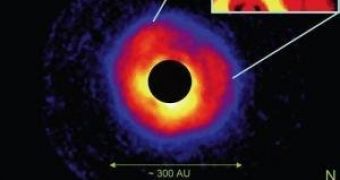The star system we talk about is located around a well-studied star known as AB Aurigae. The star is relatively young and surrounded by a disk of material created from a gas and dust cloud that seems to be forming some kind of object inside it, like the gas giant of a brown dwarf star. Co-author of the study, Ben R. Oppenheimer of the Department of Astrophysics at the American Museum of Natural History argues that the object may have a mass from 5 to 37 times the mass of Jupiter, and its study could represent an important step into understanding the evolution of exo-planets and that of our solar system nonetheless.
Star systems begin their lives in massive clouds of dust and gas. At some point in time, matter inside the cloud begins to collapse on itself under the action of gravity to form a massive central object, a star. The remnant material from the formation of the star is reorganized by gravity into a disk-shaped structure orbiting the star, in which planets, brown dwarfs or even normal stars may form.
In the image provided by the authors of the study, you can clearly see that the shape of the disk of matter is not perfectly circular, but it takes a slight horseshoe shape towards the upper-right region of the star, as seen in the image. The darker area surrounded by the two dense structures of matter is believed to be home to a newly forming planet of a brown dwarf.
A closer examination of the image reveals that, right in the center of the dark area, a bright spot of light is visible, too bright to be associated with an already formed planet, meaning that the object is still in an accretion phase, gathering material from the two bright clumps of matter located relatively equidistant from the object. Astronomers believe that the two masses of matter lead and trail the forming object on its orbit around the star, in a similar way predicted through planet formation models.
Oppenheimer said: "The deficit of material could be due to a planet forming and sucking material onto it, coalescing into a small point in the image and clearing material in the immediate surroundings. This would look like a hole in the disk. We are seeing something happening in the disk that seems to be indicative of the formation of a small body, either a planet or a brown dwarf."
Since the search for exo-planets began more than 15 years ago, more than 270 planets have been discovered through various detection methods, most of them being comparable in size with Jupiter and orbiting their star from a close distance. However, none of the found planets were directly observed until now.
The observations were conducted with the help of the U.S. Air Force telescope on Maui, Hawaii, which is capable of compensating for the disturbances produced by the motion of the air masses in the Earth's atmosphere. Solar coronagraphy was used to block the bright emission of light coming from the star of the system, so that contrast is increased and the faint glow of light from the object around it becomes obvious.
Additionally, by implying the help of a polarization filter, Oppenheimer was able to filter out the light coming from the star and that scattered out through the disk of material. By doing so, objects 100,000 times less bright than the star at a distance of only half of an arcsecond become visible.
"More detailed observations of this star can help resolve questions about how some planets form, and can possible test competing theories. And if this object is a brown dwarf, our understanding of them must be revamped", said Oppenheimer.
The object found by Oppenheimer's research team is orbiting its star from a distance of about 150 astronomical units. To make a slight comparison, the orbit of Neptune would correspond exactly to that of the edge of the black circle if it were to orbit around AB Aurigae.

 14 DAY TRIAL //
14 DAY TRIAL //